
General elections were held in Denmark on 20 November 2001. For the first time since the 1924 elections, the Social Democrats did not win the most seats. Anders Fogh Rasmussen of the centre-right Venstre became Prime Minister in coalition with the Conservative People's Party, as the head of the first Rasmussen government, with the support from Danish People's Party.

General elections were held in Sweden on 15 September 2002, alongside municipal and county council elections. The Swedish Social Democratic Party remained the largest party in the Riksdag, winning 144 of the 349 seats.

There are three types of elections in Denmark: elections to the national parliament, local elections, and elections to the European Parliament. Referendums may also be called to consult the Danish citizens directly on an issue of national concern.

General elections were held in Denmark on 12 December 1990. Although the election resulted in a strong gain for the Social Democratic Party, Poul Schlüter's coalition government was able to continue despite the Danish Social Liberal Party leaving. Schlüter's coalition consisted of the Conservative People's Party and Venstre. Voter turnout was 83% in Denmark proper, 54% in the Faroe Islands and 51% in Greenland.

General elections were held in Denmark on 8 February 2005. Prime Minister Anders Fogh Rasmussen's Venstre remained the largest party in the Folketing and his governing coalition with the Conservative People's Party remained intact, with the Danish People's Party providing the parliamentary support needed for the minority government. The Danish Social Liberal Party made the biggest gains of any party, although it remained outside the governing group of parties. The elections marked the second time in a row that the Social Democrats were not the largest party in parliament, a change from most of the 20th century. The Social Democrats lost five seats and leader Mogens Lykketoft resigned immediately after the elections. Voter turnout was 85% in Denmark proper, 73% in the Faroe Islands and 59% in Greenland.
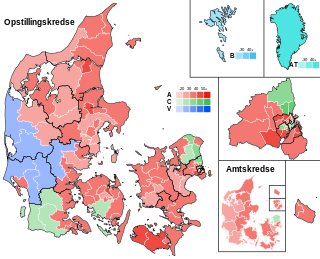
General elections were held in Denmark on 10 January 1984, after the opposition voted against the centre-right four-party government's state budget bill. Although the Social Democratic Party remained the largest in the Folketing with 56 of the 179 seats, the Conservative People's Party achieved its best-ever result, gaining 16 seats. The coalition partners Venstre and the Christian People's Party also increased their representation, although the fourth government party, the Centre Democrats, lost seven of their 15 seats. Overall the coalition government won three more seats, and Poul Schlüter continued as prime minister.
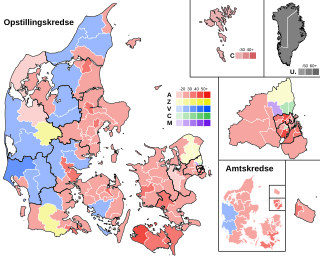
General elections were held in Denmark on 4 December 1973 and in the Faroe Islands on 13 December. It has since been referred to as the Landslide Election, as five new or previously unrepresented parties won seats, and more than half the members of the parliament were replaced. The Social Democratic Party, which had led a minority government until this election, lost a third of their seats. After the election Poul Hartling, the leader of the liberal Venstre, formed the smallest minority government in Denmark's history with only 22 seats, supported by the Progress Party, the Conservative People's Party, the Social Liberal Party, the Centre Democrats and the Christian People's Party.

General elections were held in Sweden on 16 September 1979. Although the Swedish Social Democratic Party remained the largest party, winning 154 of the 349 seats in the Riksdag, the liberal interim government of Ola Ullsten was succeeded by another centre-right coalition government composed of the People's Party, the Moderate Party and the Centre Party, led by Centre Party leader Thorbjörn Fälldin. The three parties together won 175 seats, compared to the 174 won by the Social Democrats and Communists. It was the only time that non-socialist parties retained power in an election between 1928 and 2010. The Moderates dramatically increased their representation in the Riksdag, becoming the largest party of the non-socialist bloc, a position they maintained until 2022.
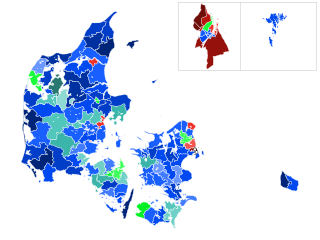
Folketing elections were held in Denmark on 3 April 1901.
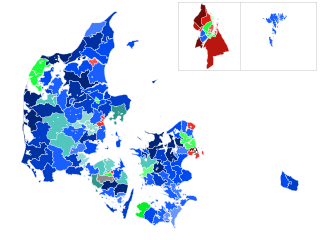
Folketing elections were held in Denmark on 16 June 1903.
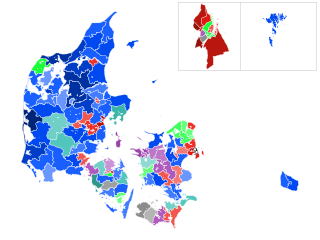
Folketing elections were held in Denmark on 29 May 1906. The result was a victory for the Venstre Reform Party, which won 56 of the 114 seats. Voter turnout was 69.8%.
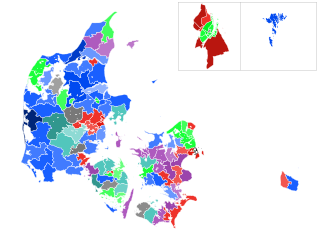
Folketing elections were held in Denmark on 25 May 1909. Although the Social Democratic Party received the largest share of the vote, the Venstre Reform Party won the most seats. Voter turnout was 71%.

Folketing elections were held in Denmark on 20 May 1913. Although the Social Democratic Party received the most votes, Venstre won the most seats. Voter turnout was 74.5%.

Folketing elections were held in Denmark on 22 April 1918, the first in which women could vote. The result was a victory for Venstre, which won 45 of the 140 seats in the Folketing, which had been expanded from 114 to 140 seats. Voter turnout was 75.5%.

Folketing elections were held in Denmark on 6 July 1920, except in the Faroe Islands, where they were held on 3 August. The result was a victory for Venstre, which won 51 of the 140 seats. Voter turnout was 74.9% in Denmark proper and 46.4% in the Faroe Islands.

Folketing elections were held in Denmark on 21 September 1920, except in the Faroe Islands, where they were held on 30 October. They were the first in which South Jutland County participated since the Schleswig Plebiscites and the return to Danish rule, and the total number of seats in the Folketing was increased from 140 to 149. The result was a victory for Venstre, which won 51 of the 149 seats. Voter turnout was 77.0% in Denmark proper and 56.2% in the Faroe Islands.

Folketing elections were held in Denmark on 23 March 1943 alongside Landsting elections, except in the Faroe Islands where they were held on 3 May. They were the first and only parliamentary elections held during the German occupation, and although many people feared how the Germans might react, they took place peacefully.

Folketing elections were held in Denmark on 28 October 1947, except in the Faroe Islands where they were held on 18 February 1948. The Social Democratic Party remained the largest in the Folketing, with 57 of the 150 seats. Voter turnout was 86% in Denmark proper and 60% in the Faroes.

Moderate Venstre, also known as the Moderate Liberals or Moderate Left, was a political party in Denmark.
The Liberal Centre was a political party in Denmark between 1965 and 1969.























